TITUSVILLE, FL OVERVIEW
Titusville was founded in 1867 when Confederate Col. Henry Theodore Titus stepped ashore on the banks of the Indian River, although the first U. S. Post Office in the area was established in 1859 in what was then known as Sand Point. Col. Titus came to Sand Point with the idea of building a town on land owned by his wife Mary, and overlooking the Indian River where they had first stepped ashore, they built the first hotel and named it “The Titus House”. The Colonel and Mary donated land for the first courthouse, four churches, laid out many of the town’s streets, and established a link to the outside world by connecting the St. Johns and Indian Rivers with mule-drawn wagons.
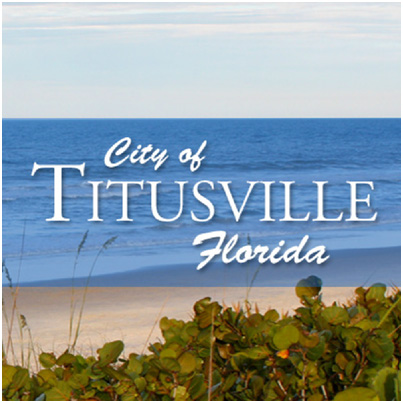
Today’s “Titusville” might have been known as “Riceville” except for the craftiness of Col. Titus who won a challenge match of dominoes against Capt. Clark Rice to determine which player got to rename the town. Thus the outcome of a domino game resulted in Sand Point becoming Titusville, Florida in 1873.
In the 1880s, Titusville became the birthplace for commercial shipments of the famous Indian River Citrus from Dummitt Grove. With the 1880s and 1890s also came the establishment of the first bank, two newspapers, founding of a fishing Industry, railroad connection between Titusville and Enterprise on the north shore of Lake Monroe near Sanford, extension of the railroad from Jacksonville south along the East Coast with Titusville’s first railroad station being constructed in 1892. Other highlights of the period included a few devastating fires and freezes. Of special note is the incorporation of Titusville in 1887 and the organization of a Board of Trade which was the forerunner of the present day Chamber of Commerce. Shortly after the turn of the century focus was on construction of schools, roads and a bridge across the Indian River to make it possible for easy access to Playalinda and Desoto Beaches. A water system was installed, a fire department was founded, a second bank was established, first permanent street paving was accomplished and stormwater drainage systems were installed.
Titusville was deeply affected by the burst of the Florida Boom in the mid 1920s and the economic depression of the 1930s. Since no airports existed on the east coast between Jacksonville and Miami a highlight of 1927 was the opening of present day Arthur Dunn Airpark for use as an emergency landing field for the airmail service of the times. During World War II many enemy ships were sunk off nearby beaches, a boat construction company built hundreds of landing craft at a plant located at the yacht basin. A Navy fighter field was also established just south of Titusville which today is known as Space Coast Regional Airport.
The 1950s and early 1960s were a period of steady growth with additional population increases being counted when the towns of Whispering Hills and Indian River City were consolidated with Titusville. The 60’s also commenced man’s conquest of space and with Kennedy Space Center came the accompanying boom which produced the first motels, the first multi-rise apartment building, a public hospital, shopping centers, new golf courses, churches, and sub-divisions.
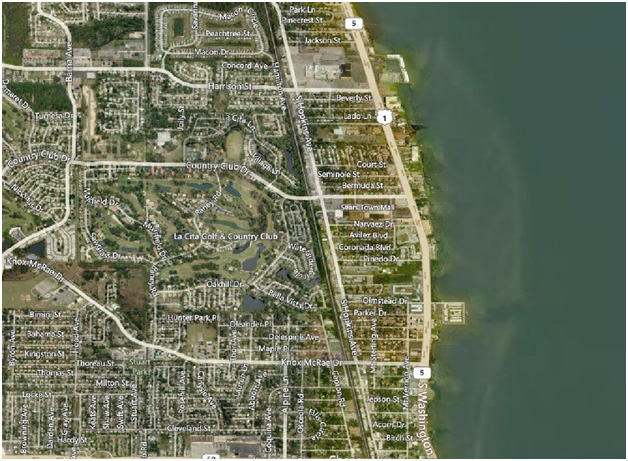
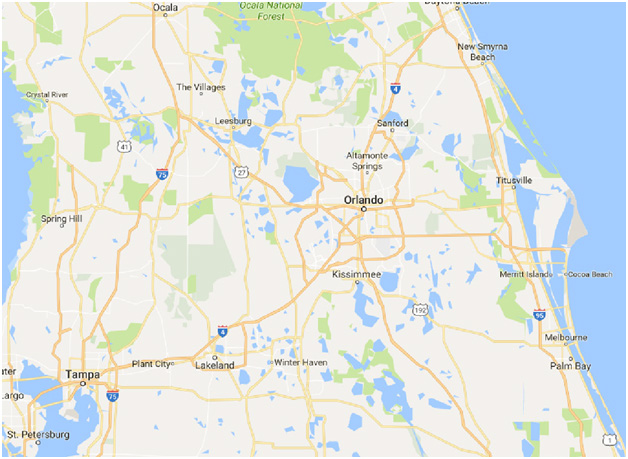
Titusville was deeply affected by the burst of the Florida Boom in the mid 1920s and the economic depression of the 1930s. Since no airports existed on the east coast between Jacksonville and Miami a highlight of 1927 was the opening of present day Arthur Dunn Airpark for use as an emergency landing field for the airmail service of the times. During World War II many enemy ships were sunk off nearby beaches, a boat construction company built hundreds of landing craft at a plant located at the yacht basin. A Navy fighter field was also established just south of Titusville which today is known as Space Coast Regional Airport.
The 1950s and early 1960s were a period of steady growth with additional population increases being counted when the towns of Whispering Hills and Indian River City were consolidated with Titusville. The 60’s also commenced man’s conquest of space and with Kennedy Space Center came the accompanying boom which produced the first motels, the first multi-rise apartment building, a public hospital, shopping centers, new golf courses, churches, and sub-divisions.
BREVARD COUNTY OVERVIEW
While tourism is often considered the largest economic driver, Brevard County’s economy is largely driven by the Aerospace and Engineering Industry. The high skilled, high wage jobs have a huge impact on the region but the industry has also caused a great deal of volatility in the local economy. Over the past twenty years the aerospace and engineering industry, and subsequently the local economy, has gone through many devastating ups and downs that largely revolve around the space program. Although the concept has been expanding over the last two decades, privatization of the space industry has been fully implemented with impacts already being seen.
The Kennedy Space Center
The Space Shuttle Program was NASA’s manned launch vehicle program from 1981-2010. In 2004 George W. Bush called for the Space Shuttle Program’s retirement in 2010 but funded the development of the next program, Project Constellation, to take its place. In 2010, the Obama Administration cancelled Project Constellation calling it, “over budget, behind schedule, and lacking in innovation.” Brevard County was rocked by this decision and as a result the regional economy crashed. Thousands of highly skilled and high wage employees lost their jobs and some left the region as they secured jobs in their industry elsewhere.
Developing over the past decade, NASA has created the “competitive space launch market” to create a more reliable access to space. Through the Commercial Orbital Transportation Services, a NASA program tha allows private companies to bid on contracts to bring payloads to the International Space Station, NASA has tested the reliability of privatizing the space industry. Now NASA is applying the concept to manned space flight which was brought to a halt after the retirement of the Space Shuttle Program and the cancellation of Project Constellation. United Launch Alliance, a partnership between Lockheed Martin and Boeing, is currently redeveloping launch pads at the Kennedy Space Center to handle the new vehicles that will transport humans to space by 2021. In the Hillsborough County economy. Significant companies in the sector include Publix; Pinellas County School District; and MacDill Air-force Base Tourism also accounts for a big share of employment in Tampa. Noteworthy employers in the tourism sector are cruise ship operators such as Carnival Cruise Lines and Royal Caribbean International.
Other large employers in the county are public-sector agencies and population-serving enterprises such as educational institutions, government services and healthcare facilities. Some of the major employers in the healthcare field are Tampa General Hospital, Brandon Regional Hospital and Memorial Hospital of Tampa.
Impact on Brevard County
Brevard County’s economy relies heavily on manned space flight, which in-turn relied entirely on the Space Shuttle Program. Manned space exploration was only able to operate under one contract through the Space Shuttle Program. Now that the space industry has been privatized, multiple companies are bidding on contracts to take humans to space. Companies such as Lockheed Martin, Boeing, SpaceX, Blue Origin, and NASA are all developing rockets and manned space flight capsules and will be able to bid on these contracts. Instead of manned space flight relying on one contract and one vehicle to bring humans to space, the competitive space market decentralizes the industry by letting private companies develop and launch their vehicles. Economically speaking, high wage jobs will be more secure due to the fact that multiple private companies are now bidding on launches.
The Brevard County submarket’s economy is largely driven by the aerospace and engineering industry. Companies like Boeing, Lockheed Martin, SpaceX, etc. are located in Brevard to support the activities at the Kennedy Space Center. The submarket recently experienced deep economic hardship due to the discontinuation of the Space Shuttle Program and the reorganization of the entire space industry. Now, the space industry has been privatized in order to increase efficiency and reduce cost. The void that the Space Shuttle Program left has now been filled by many new private aerospace companies that have created thousands of new jobs.
All Aboard Florida
All Aboard Florida will be America’s only privately owned and operated, inter-city passenger rail system, which hasn’t been done in 30 years. This project will connect Orlando from the Orlando International Airport to Miami at the new station Miami Central just outside of the Dade County courthouse. The passenger train line will also have a stop in Fort Lauderdale and West Palm Beach.
Currently Amtrak, a government subsidized passenger rail operator, can take passengers between Miami to Orlando but is criticized for not having accessible stations, not having amenities like Wi-Fi and dining, and not being on time delaying the already 5-6 hour travel. All Aboard Florida will offer a 3 hour trip, amenities like Wi-Fi and dining, online reservations, advanced baggage checking, and a Positive Train Control. Without PTC, a braking technology that can stop a train who’s conductor doesn’t follow signals, a train may not go faster than 79 mph making All Aboard Florida able to achieve faster travel time. All Aboard Florida’s faster travel time can also be attributed to the use of the Florida East Coast Railway, which hasn’t carried a passenger train since 1968. In addition to the use of the current Florida East Coast Railway, this company will be extending the rail from Cocoa to the Orlando International Airport. An affiliate of Fortress Investment Group owns both the Florida East Coast Railway and Florida East Coast Industries which owns Flagler Global Logistics, a company that is developing the Titusville Logistics Center positioned on the East Coast Railway within close proximity to Port Canaveral’s cargo facility. All Aboard Florida – Operations LLC, who owns the easements for the railway from Orlando to Cocoa, and All Aboard Florida – Stations LLC, who owns the land for the Miami stations, are both owned by Florida East Coast Industries.
This parent company is very highly invested and plans for this railway to experience large increase in traffic not only due to All Aboard Florida but the increase in freight traffic from the Port of Miami and Port Canaveral. Both ports are now deep and wide enough to service more international cargo trade which will increase as the Panama Canal’s expansion project to nearly double its capacity is nearing completion. All Aboard Florida will consist of two phases: the first will be to improve, and in some parts double track, the existing 195 mile rail along the South Florida to Cocoa corridor and the second is to construct 40 miles of new rail along 528 from Cocoa to the Orlando International Airport. The project is expected to cost 1.2 billion, part of which will be federally funded, and should be operational by 2017.
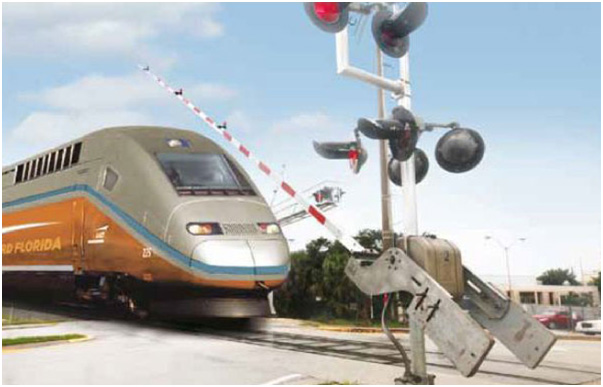
All Aboard Florida
This parent company is very highly invested and plans for this railway to experience large increase in traffic not only due to All Aboard Florida but the increase in freight traffic from the Port of Miami and Port Canaveral. Both ports are now deep and wide enough to service more international cargo trade which will increase as the Panama Canal’s expansion project to nearly double its capacity is nearing completion. All Aboard Florida will consist of two phases: the first will be to improve, and in some parts double track, the existing 195 mile rail along the South Florida to Cocoa corridor and the second is to construct 40 miles of new rail along 528 from Cocoa to the Orlando International Airport. The project is expected to cost 1.2 billion, part of which will be federally funded, and should be operational by 2017.
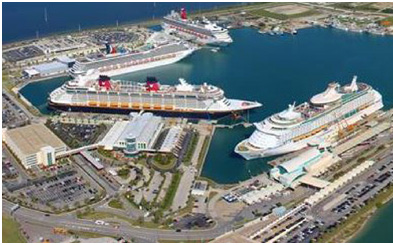
Cruise Terminal
Port Canaveral is trying to take over Miami’s position of number 1 cruise port. In December 2014, Port Canaveral unveiled their 354 million dollar, 188,000 sq. ft. cruise terminal along with a 1,000 space parking facility. There are also plans to open additional cruise terminals.
There are three cruise lines that use this port as a homeport for their ships including Royal Caribbean International, Carnival Cruise Line, and Disney Cruise Line.
Gulftainer
Port Canaveral and GT USA signed a 35 year agreement in which GT USA will spend 100 million dollars to develop and operate a multi- functional cargo terminal in Port Canaveral that will attract international trade. The cargo port began operations in Q4 of 2014 and is working on developing supply chain solutions. In the development plans GT USA has widened the channel 100 feet to 500 feet and plans to deepen the channel to 55 feet. Port Canaveral is an attractive terminal because it has direct access to the Atlantic Ocean, it lies within FTZ 136, it has direct access to major highways, and in 2017 it will have a direct connection to the Florida East Coast Railway.
Port Canaveral Crossings
Port Canaveral has recently purchased Canaveral Crossings, a 270-acre proposed industrial site that will service the influx of cargo coming from the ports new and expanding cargo terminal. This site is 12 miles from Port Canaveral, 35 miles from Orlando International Airport, has roadway access to Florida East Coast Railway, and is 0.5 mile to I-95 which extends up the east coast through Maine.
